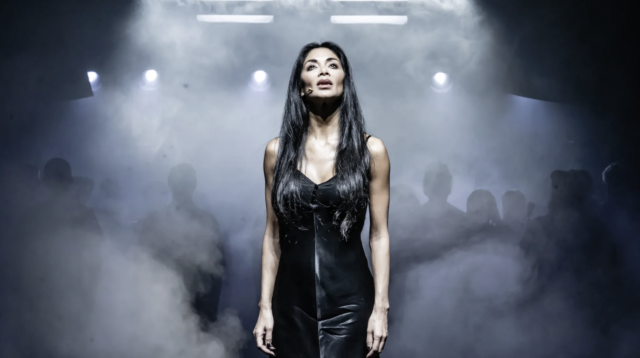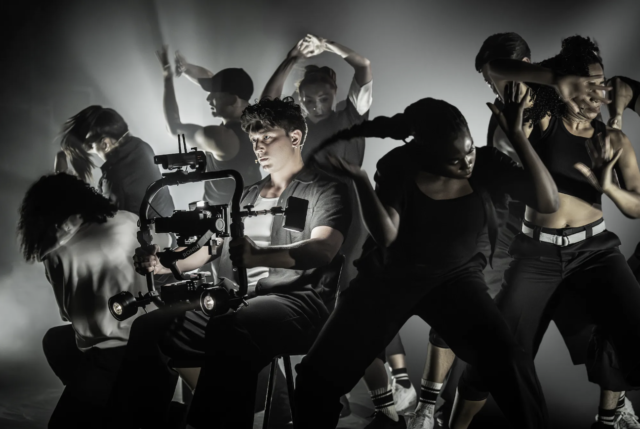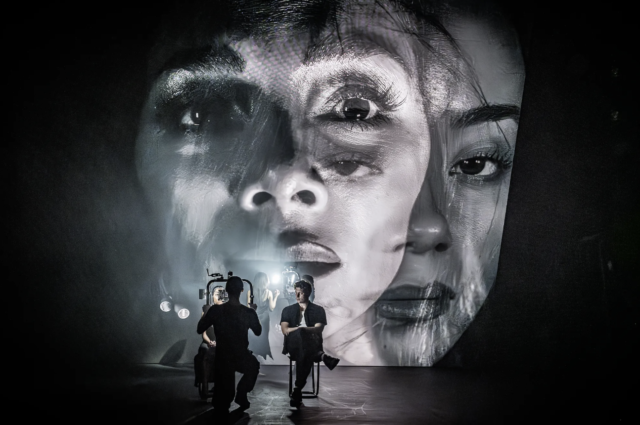
Nicole Scherzinger sizzles as Norma Desmond in Sunset Blvd. revival (photo by Marc Brenner)
SUNSET BLVD.
St. James Theatre
246 West Forty-Fourth St. between Broadway & Eighth Aves.
Tuesday – Sunday through July 6, $59-$424
sunsetblvdbroadway.com
In 2017, the most memorable part of Lonny Price’s Broadway revival of Andrew Lloyd Webber’s Tony-winning Sunset Boulevard took place offstage, when, just before curtain, Hillary Clinton arrived and sat in the orchestra, receiving a standing ovation. It had been less than a month since Donald Trump had taken the oath of office as the newly elected president of the United States, having defeated Clinton in the Electoral College (but not in the popular vote). Close had supported Clinton’s run, so the moment was a palpable one, especially at a show about a woman hell-bent on making a comeback.
The most memorable parts of Jamie Lloyd’s current revival also take place offstage. The second act begins with Tom Francis, who plays screenwriter Joe Gillis, emerging from his dressing room at the St. James Theatre — where he was watching Billy Wilder’s 1950 film version — then descending several flights of stairs, greeting members of the cast and crew, and heading outside to perform the title song while walking down Forty-Fourth St. and across Shubert Alley before returning to the theater with the ensemble behind him.
The other occurred when Nicole Scherzinger, who stars as Norma Desmond in the musical, responded to an Instagram post by Russell Brand on election night in which the Trump-supporting English comedian waved a red MAGA-style cap with the words “Make Jesus First Again” on it, asking where she could get that hat. A media firestorm erupted — how dare a Broadway actress possibly support Trump! — and Scherzinger ultimately deleted the comment and apologized, explaining that she was not taking political sides but sharing her beliefs in love, faith, and Jesus.
Okay, so what about what happens onstage? Well, it’s a confusing barrage of ear-piercing music and a giant screen that tries to make you forget how disappointingly mediocre the show is, although Scherzinger is electrifying.

Tom Francis, who plays Joe Gillis, operates a live-feed camera at the St. James Theatre (photo by Marc Brenner)
The plot takes a backseat to Lloyd’s overwrought staging, but it’s in there. Norma was a silent film star who has not made the transition to talking pictures; she’s holed up in her mansion, where her butler, Max Von Mayerling (David Thaxton), attends to her every need and fiercely defends and supports her. She is writing a script that she is sure Hollywood impresario Cecil B. DeMille (usually played by Shavey Brown, though I saw understudy Brandon Lavar) will make, returning her to the limelight.
Joe is a broke hack pitching his original screenplay, called Bases Loaded, to producer Sheldrake (Tyler Davis), whose assistant, Betty Schaefer (Grace Hodgett Young), is a fan of his and offers to help him. Betty is engaged to Joe’s friend and fellow screenwriter, Artie Green (Diego Andres Rodriguez). On the run from a pair of repo men who are after his car, Joe soon finds himself at Norma’s home, working with her on her screenplay (and in the bedroom), getting paid handsomely for his efforts. The narrative takes a dramatic shift when Norma and Joe visit DeMille at Paramount to discuss her movie.
Soutra Gilmour’s dark, bare set is often immersed in smoke, referring to both the cigarettes that were so prevalent in films noir as well as the hell that Norma and Joe are living in. Lloyd gets carried away with one of the greatest lines in cinema history; when Norma says, “I am big. It’s the pictures that got small,” it stands in stark contrast to the twenty-three-foot-tall screen on which the characters are too often projected. There are just so many nostril shots that one can forgive. (The in-your-face live video is designed by cinematographers Nathan Amzi and Joe Ransom.)
It is odd that the screen lowers at an angle, not straight up and down. It is even odder that in order to get the shots, camera operators with equipment strapped across their bodies, looking completely alien in what is supposed to be old-time Hollywood, crowd the stage; the actors don’t play to the audience but to the cameras. At times, if you watch the screen, it appears that Joe is speaking directly with Norma, but in actuality they are facing different directions on the set.

Multimedia Sunset Blvd. revival makes it hard for the audience to know where to look (photo by Marc Brenner)
This hybrid approach — Lloyd opens and closes the show with movielike credits projected on the screen — sacrifices theatrical elements in favor of cinematic effects that drain scenes of power, as if admitting that this is a flawed musical that can’t stand on its own. In honoring the movie version in this way, it is also a constant reminder that Thaxton is not Erich von Stroheim, Francis is not William Holden, and Scherzinger is not Gloria Swanson. The film, written by Wilder and Charles Brackett, is a masterpiece about the fickle Hollywood studio system and the allure, and cost, of fame and fortune. Two-time Tony nominee Lloyd is a minimalist who has directed exemplary versions of Cyrano de Bergerac, Betrayal, and A Doll’s House as well as the visually stunning The Effect. But he gets caught in the middle with Sunset Blvd. — he has abbreviated the second word of the title, as if emphasizing his minimalism while also acknowledging the way the title first appears in the film — leaving fans of the musical and the movie scratching their head.
Sunset Boulevard has what is considered one of Lloyd Webber’s best scores, but that doesn’t mean it’s exceptional. There’s not much anyone can do to save such clunkers as “Let’s Have Lunch,” “Every Movie’s a Circus,” and “This Time Next Year,” although Thaxton nails “The Greatest Star of All,” and Scherzinger sizzles on “With One Look” and “As If We Never Said Goodbye,” receiving scattered show-stopping applause. The book and lyrics, by Don Black and Christopher Hampton, are fraught with underdeveloped characters and clichés even as they try to remain faithful to the movie. Fabian Aloise’s choreography is daring, performed by a talented ensemble; most poignantly, Hannah Yun Chamberlain plays a younger version of Norma, occasionally echoing her movement as the older Norma recalls her past success. Gilmour dresses the full troupe in black-and-white costumes, furthering the noir feel, along with Jack Knowles’s lighting and Adam Fisher’s sound.
Scherzinger (Guys and Dolls, Chicago), former lead singer of the girl group the Pussycat Dolls, firmly steps into a role previously performed by Rita Moreno, Betty Buckley, Patti LuPone, Diahann Carroll, and Petula Clark, availing herself well. She’s a camp vamp version, wearing the same long, slinky black dress through the whole show, barefoot, contorting her face and body as she glides across the stage. At forty-six she’s equivalent in age to Close, who was forty-seven the first time she played the part, and to Swanson, who was fifty when she made the film. Scherzinger is a determinedly sexier Norma, who is still mad from the start, creating a compelling dichotomy. I’m not sure that’s enough to recommend the show; the night I went, when the audience erupted into a thunderous, extended ovation during the curtain call, my friend and I couldn’t help but wonder whether they saw the same musical that we did.
I also still have trouble with the final minute, when Norma delivers one of the greatest closing lines in cinema history — and Lloyd Webber follows it with a brief reprise of “With One Look.”
No. Just no, regardless of who this Norma might have voted for.
[Mark Rifkin is a Brooklyn-born, Manhattan-based writer and editor; you can follow him on Substack here.]